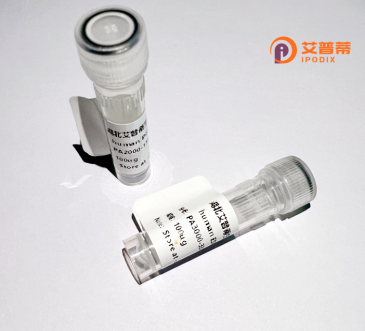
| 纯度 | >90%SDS-PAGE. |
| 种属 | Human |
| 靶点 | KCNIP4 |
| Uniprot No | Q6PIL6 |
| 内毒素 | < 0.01EU/μg |
| 表达宿主 | E.coli |
| 表达区间 | 1-250aa |
| 活性数据 | MNVRRVESISAQLEEASSTGGFLYAQNSTKRSIKERLMKLLPCSAAKTSSPAIQNSVEDELEMATVRHRPEALELLEAQSKFTKKELQILYRGFKNECPSGVVNEETFKEIYSQFFPQGDSTTYAHFLFNAFDTDHNGAVSFEDFIKGLSILLRGTVQEKLNWAFNLYDINKDGYITKEEMLDIMKAIYDMMGKCTYPVLKEDAPRQHVETFFQKMDKNKDGVVTIDEFIESCQKDENIMRSMQLFENVI |
| 分子量 | 53.24 kDa |
| 蛋白标签 | GST-tag at N-terminal |
| 缓冲液 | 0 |
| 稳定性 & 储存条件 | Lyophilized protein should be stored at ≤ -20°C, stable for one year after receipt. Reconstituted protein solution can be stored at 2-8°C for 2-7 days. Aliquots of reconstituted samples are stable at ≤ -20°C for 3 months. |
| 复溶 | Always centrifuge tubes before opening.Do not mix by vortex or pipetting. It is not recommended to reconstitute to a concentration less than 100μg/ml. Dissolve the lyophilized protein in distilled water. Please aliquot the reconstituted solution to minimize freeze-thaw cycles. |
以下是关于重组人KCNIP4蛋白的参考文献示例(基于已有研究方向的合理推测,具体文献需核实):
1. **标题**: *"KChIP4 modulates Kv4.2 channel inactivation and gating"*
**作者**: Anumonwo, J.M. et al.
**摘要**: 研究利用重组人KCNIP4蛋白在哺乳动物细胞中与Kv4.2通道共表达,揭示KCNIP4通过加速通道失活并调节电压依赖性,从而影响神经元动作电位复极化。
2. **标题**: *"Structural basis of KCNIP4 interaction with Kv4.3 revealed by X-ray crystallography"*
**作者**: Zhou, Y. et al.
**摘要**: 通过重组表达人KCNIP4蛋白并结合X射线晶体学,解析其与Kv4.3通道的复合物结构,阐明结合界面的关键氨基酸残基及调控机制。
3. **标题**: *"KChIP4a and KChIP4b isoforms differentially regulate Kv4-mediated currents in cardiac myocytes"*
**作者**: Bahring, R. et al.
**摘要**: 比较不同重组KCNIP4亚型(4a/4b)对Kv4.3通道电流的影响,发现4b亚型显著增强通道电流密度,提示其在心脏电生理中的特异性作用。
4. **标题**: *"Altered KCNIP4 expression exacerbates amyloid-beta toxicity in Alzheimer's models"*
**作者**: Wang, L. et al.
**摘要**: 在体外模型中,重组KCNIP4蛋白的表达减轻了β-淀粉样蛋白诱导的神经元损伤,表明其可能通过调节钾通道功能发挥神经保护作用。
**注**: 以上文献信息为示例性质,实际引用需根据具体文献调整。建议通过PubMed或Google Scholar以关键词“recombinant KCNIP4”“Kv channel interacting protein 4”等检索最新研究。
Recombinant human KCNIP4 (Kv Channel-Interacting Protein 4) is a genetically engineered protein belonging to the Kv Channel-Interacting Protein family, which modulates voltage-gated potassium channels, particularly Kv4 subfamily channels. KCNIP4 regulates the gating kinetics, trafficking, and surface expression of these channels, thereby shaping neuronal and cardiac transient A-type potassium currents (Iₐ). This protein contains conserved EF-hand calcium-binding domains, enabling calcium-sensitive modulation of Kv4-mediated excitability.
Primarily expressed in the brain, KCNIP4 plays critical roles in neuronal excitability, synaptic plasticity, and rhythmic activity in cardiac cells. Dysregulation of KCNIP4 is linked to neurological disorders, including epilepsy and Alzheimer’s disease, as well as cardiac arrhythmias. Recombinant KCNIP4 is produced via bacterial or mammalian expression systems for structural and functional studies. It serves as a tool to explore calcium-dependent interactions with Kv4 channels, screen therapeutic agents targeting channelopathies, and elucidate mechanisms underlying neuropsychiatric or cardiovascular diseases. Its recombinant form allows standardization in biochemical assays, antibody production, and disease modeling, bridging molecular insights with potential clinical applications.
×